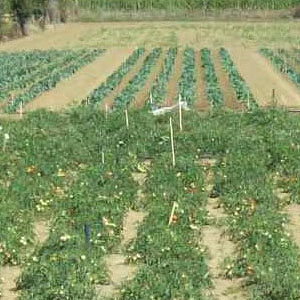Does the timing of short-term biowaste compost application affect crop growth and potential nitrate leaching? The case studies of processing tomato and cauliflower under field conditions

Accepted: 3 June 2022
HTML: 20
All claims expressed in this article are solely those of the authors and do not necessarily represent those of their affiliated organizations, or those of the publisher, the editors and the reviewers. Any product that may be evaluated in this article or claim that may be made by its manufacturer is not guaranteed or endorsed by the publisher.
The feasibility of municipal solid waste compost (MSWC) as a substitute for mineral nitrogen (N) fertiliser was tested for a spring-summer (i.e., processing tomato) and an autumn-winter (i.e., cauliflower) vegetable crop grown in Mediterranean open field conditions. Two different doses (10 and 20 t dm C ha–1) and two distribution timings for each dose (i.e., early application at about nine months before processing tomato transplanting and five months before cauliflower transplanting: C10_early and C20_early; late application at about one month before processing tomato and cauliflower transplanting: C10_late and C20_late) were compared in a two-year field experiment. An unfertilised control and a 100% mineral N fertilisation (MIN, 200 kg N ha–1 for processing tomato and 150 kg N ha–1 for cauliflower) were added to the experiment. The application of MSWC significantly reduced the aboveground DM accumulation compared to the MIN in both crops, and it was inadequate to ensure a high yield for spring-summer and autumn-winter vegetables. However, the timing of compost application seems to play an essential role in reducing the reduction of crop growth due to compost application. In both tomato and cauliflower, when the MSWC was applied a few months earlier than the transplanting (i.e., in the previous summer in tomato and the previous spring in cauliflower), the DM and yield reduction was less apparent than in soil where compost was applied immediately before transplanting. Despite the lowest N-uptake associated with the MSWC application, the N-NO3 concentration in the soil solution was reduced by MSWC. In addition to the amendment effect, compost use may positively impact lowering N leaching risks in the groundwater. Combining the use of MSWC applied early before the crop season with mineral N fertiliser, it is possible to gain high yield, increase soil organic carbon and reduce groundwater contamination risk both in spring-summer and autumn-winter vegetable crops.
Highlights
- Biowaste compost decreased the aboveground biomass accumulation and yield in processing tomato and cauliflower.
- Biowaste compost alone did not meet the N requirement in processing tomato and cauliflower.
- Biowaste compost distribution in the summer before the processing tomato growing season alleviated its depressive effect in reducing DM and yield.
- Biowaste compost distribution in the spring before the cauliflower growing season alleviated its depressive effect in reducing DM and yield.
- Biowaste compost decreased the N-NO3 concentration in soil solution compared to mineral fertilisation with a positive effect in reducing N leaching risks in the groundwater.
How to Cite

This work is licensed under a Creative Commons Attribution-NonCommercial 4.0 International License.
PAGEPress has chosen to apply the Creative Commons Attribution NonCommercial 4.0 International License (CC BY-NC 4.0) to all manuscripts to be published.

 https://doi.org/10.4081/ija.2022.2045
https://doi.org/10.4081/ija.2022.2045



